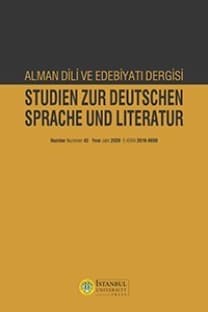Die Darstellung türkischer Migration zwischen Ort und Nicht-Ort. Züge und Bahnhöfe in Sten Nadolnys Selim oder Die Gabe der Rede und Emine Sevgi Özdamars Die Brücke vom Goldenen Horn
The Representation of Turkish Migration between Place and Non-Place. Trains and Railway Stations in Sten Nadolny's Selim oder Die Gabe der Rede and Emine Sevgi Özdamar's Die Brücke vom Goldenen HornIn the context of a cultural studies approach to literary texts – and last but not least in the course of the spatial turn – it is self-evident to take Marc Augé's theory of Non-Places into account with regard to the analysis of intercultural literature.Characteristic of the Non-Place, which has to be considered as an anonymous one according to Augé, is that it represents the opposite of the Anthropological Place. As examples for Non-Places trains, railway stations, hotels, residential homes, airports etc. can be mentioned. According to Augé, more and more Non-Places occur in times of increasing migration and globalization. These Non-Places and their representationwithin literary texts will be analyzed – especially the representation of places of transit within the context of German-Turkish migration. It is interesting to observehow individual experiences of the characters transform Non-Places into Places in fictional texts and how this development is literarily realized. There will be a special focus on literary representation of the subject's emotions and on the consequences for the construction of identity. Concretely, the theory of the Non-Place will be applied to Emine Sevgi Özdamar's Die Brücke vom Goldenen Horn and Sten Nadolny'sSelim oder Die Gabe der Rede.Keywords / Anahtar Sözcükler: anthropological place, non-place, overmodern, transit places of german-turkish migration, train, train station, time, identity
Anahtar Kelimeler:
anthropological place, non-place, overmodern, transit places of german-turkish migration, train, train station, time, identity
The Representation of Turkish Migration between Place and Non-Place. Trains and Railway Stations in Sten Nadolny‘s Selim oder Die Gabe der Rede and Emine Sevgi Özdamar’s Die Brücke vom Goldenen HornIn the context of a cultural studies approach to literary texts – and last but not least in the course of the spatial turn – it is self-evident to take Marc Augé’s theory of Non-Places into account with regard to the analysis of intercultural literature. Characteristic of the Non-Place, which has to be considered as an anonymous one according to Augé, is that it represents the opposite of the Anthropological Place. As examples for Non-Places trains, railway stations, hotels, residential homes, airports etc. can be mentioned. According to Augé, more and more Non-Places occur in times of increasing migration and globalization. These Non-Places and their representation within literary texts will be analyzed – especially the representation of places of transit within the context of German-Turkish migration. It is interesting to observe how individual experiences of the characters transform Non-Places into Places in fictional texts and how this development is literarily realized. There will be a special focus on literary representation of the subject’s emotions and on the consequences for the construction of identity. Concretely, the theory of the Non-Place will be applied to Emine Sevgi Özdamar’s Die Brücke vom Goldenen Horn and Sten Nadolny’s Selim oder Die Gabe der Rede.
- Başlangıç: 1954
- Yayıncı: İstanbul Üniversitesi
